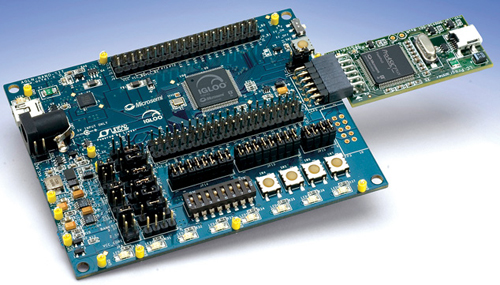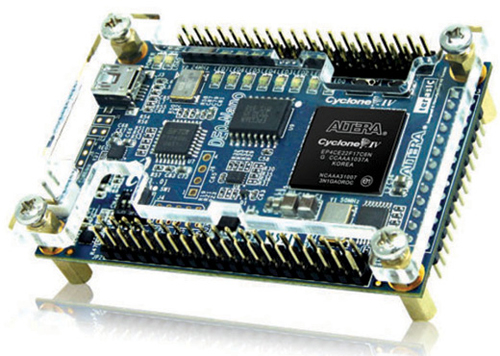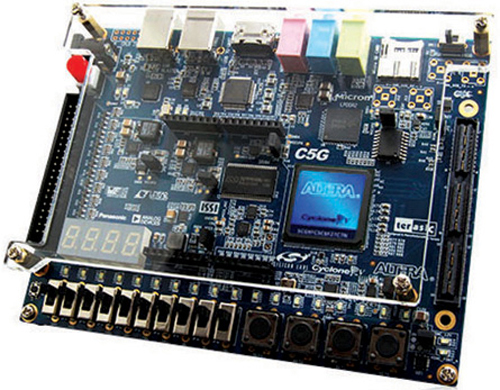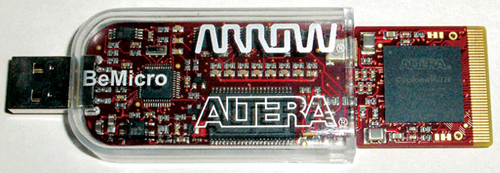
Development boards for Actel/Microsemi chips
1. Actel IGLOO nano starter kit
- Low-cost AGLN250-VQG100 device
- USB-to-UART connection for HyperTerminal on a PC
- A 20MHz system clock is provided using a low-power, precision oscillato
- Eight LEDs and four switches provide simple inputs and outputs to the system
- All I/Os available for quick connection to external circuitry
- Ability to switch VCORE from 1.2V – 1.5V
- Full current measurement capability of independent I/O banks and VCC for accurate power analysis
- Optional board power connector for an external supply, but none is needed when connected to a USB cable
- All components used on the board are low-power components, including LEDs (2 mA), resets (µA range) and oscillator (2-3 mA).
The other popular boards for Actel/Microsemi FPGA chips are Microsemi SmartFusion Evaluation Kit and TrioFlex ST32PA3-AP8.
Microsemi SmartFusion Evaluation Kit features an FPGA advertised as having 200k gates and an integrated 100MHz ARM Cortex-M3, 10/100 Ethernet PHY and on-chip MAC, USB-serial, on-board USB programming interface, OLED display, eight LEDs, two user switches and an indeterminate number of analogue and digital outputs.
TrioFlex ST32PA3-AP8 gives you an Actel A3P060 FPGA and 50MHz oscillator, with an AVR-compatible soft core preloaded in a stamp-sized module.

Development boards for Altera chips
1. DE0-Nano
- Cyclone IV EP4CE22F17C6N with EPCS64 64Mbit serial configuration device
- Built-in USB-blaster cable for FPGA configuration
- 3-axis accelerometer with 13-bit resolution
- A/D converter, eight channels and 12-bit resolution
- Expansion headers (two 40-pin headers and one 26-pin headers)
- 2-pin external power header
- 32MB SDRAM
- 2kb EEPROM
- Eight green LEDs
- Four dip switches
- Two de-bounced push-button switches

2. Cyclone V GX Starter Kit
- Cyclone V GX 5CGXFC5C6F27C7N FPGA
- Configuration status and set-up elements
- High-speed mezzanine card (HSMC) x1, including 4-lane 3.125G transceiver
- 2×20 GPIO header
- Arduino header, including analogue pins
- SMA x4 (DNI), one-lane 3.125G transceiver
- 4Gb LPDDR2 x32 bits data bus
- 4Mb SRAM x16 bits data bus
- High-definition multimedia interface (HDMI) transmitter (TX), compatible with DVI v1.0 and HDCP v1.4
- 24-bit CODEC, line-in, line-out and microphone-in jacks
- Switches, buttons, LED and seven-segment displays
- Micro-SD card socket
- Provides SPI and 4-bit SD mode for SD card access

3. Arrow BeMicro
- Altera Cyclone III FPGA—
- EP3C16F256C8N
- Altera Nios II embedded processor
- 16MHz clock oscillator
- Three status LEDs
- Eight user LEDs
- 80-pin edge connector
Arrows’ BeMicro is small but you would need the corresponding protoboard to use any of the I/Os. It is mainly intended for embedded processor development. Another board from Arrow is BeMicro SDK, which is a newer version of the BeMicro that is intended for use with the Altera Nios II processor. It includes a Cyclone IV FPGA, microSD, 10/100 Ethernet, temperature sensor, 512Mb mobile DDR, integrated programmer, eight LEDs, buttons and switches and an 80-pin edge connector. A corresponding protoboard is also available.
As Altera is equally popular as Xilinx, you will find a lot of other development boards in the market such as Terasic Altera DE0, thin-layer embedded helix_4, KNJN Pluto boards, FTDI Morph-IC-II, Wayengineer boards and Amani F2. Each board is good for something or the other but you need to decide based on your project needs. Brief of each board is described below:
Thin-layer embedded helix_4. It is a Cyclone IV module designed by an Australian company that combines 4Mb of SRAM, 512Mb of DDR2 (in the larger model), Flash and a cryptography chip in a module that is designed to be mounted directly on your own PCBs. Carrier boards compatible with Arduino shields with USB programming via a PSoC are also available.
Terasic Altera DE0. The board looks comparable to Digilent’s Nexys2, though the connectors are not suitable for high-speed use.
KNJN Pluto. These boards are cheap and small. No on-board peripherals, so they seem more suited to dropping into a larger project than as a standalone development tool.
FTDI Morph-IC-II. This board combines a Cyclone II with an FT2232H USB interface chip to provide high-speed data transfer. It has a total of 80 to 96 I/Os split between the FPGA and FT2232H.
Wayengineer. Wayengineer sells a large range of very cheap Cyclone II boards from Shenzhen, mostly with RAM and a variety of I/O including LCDs, seven-segment LEDs, VGA and switches. Again, they are of great value if you already have some experience with FPGAs, are comfortable reading schematics and do not require any vendor support.
Amani F2. It has a Cyclone II EP2C5 with 4608 LEs on an Arduino shield. It provides 74 digital I/Os, including two PMod interfaces, a JTAG port, a push button and an LED. A pad is provided for an EPCS1 Flash memory device.
Development boards for Cypress chips
The major boards for Cypress FPGA chips are PSoC 4 Pioneer, freeSoC and freeSoC Mini. PSoC 4 Pioneer is Cypress’ own cheap development board. It has a PSoC 4200, which has a Cortex-M0 and supports for both Arduino shields and Digilent PMods, a CapSense slider, RGB LED and one button. freeSoC and freeSoC Mini are not FPGA boards, but rather are boards based on the Cypress PSoC, which incorporates an ARM Cortex-M3 and reconfigurable mixed-signal logic.
The author is a technical editor at EFY






